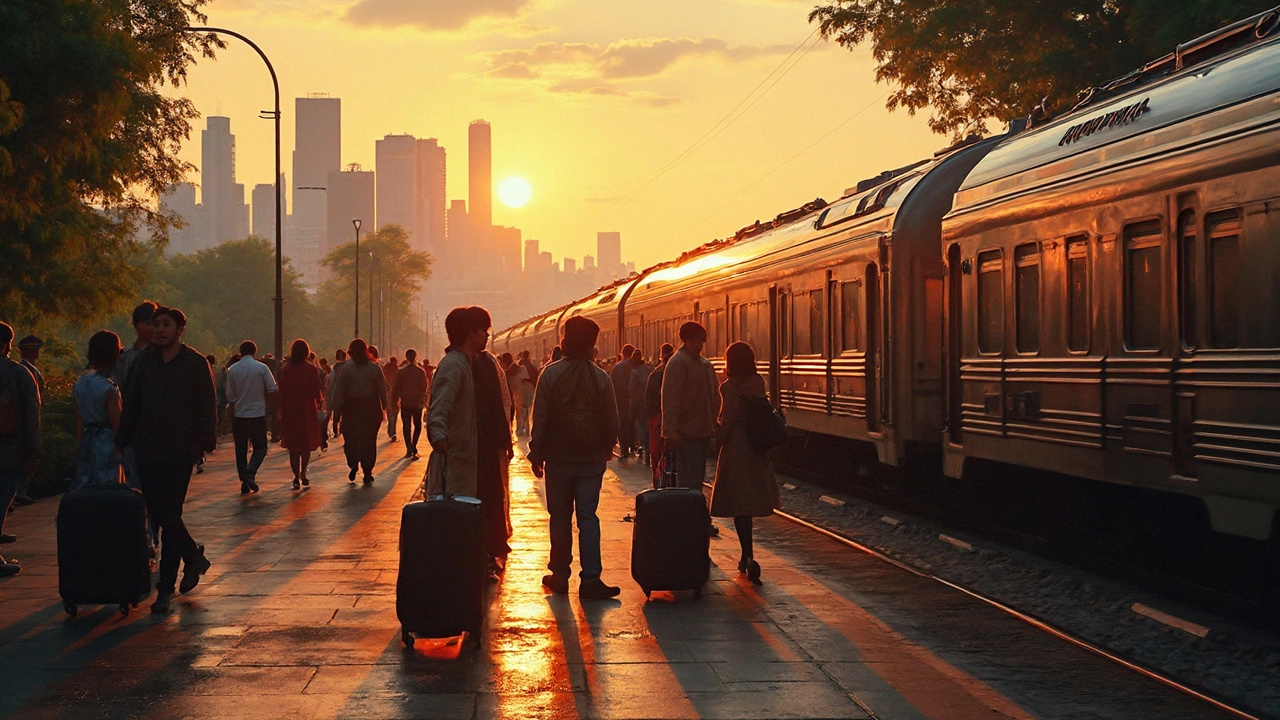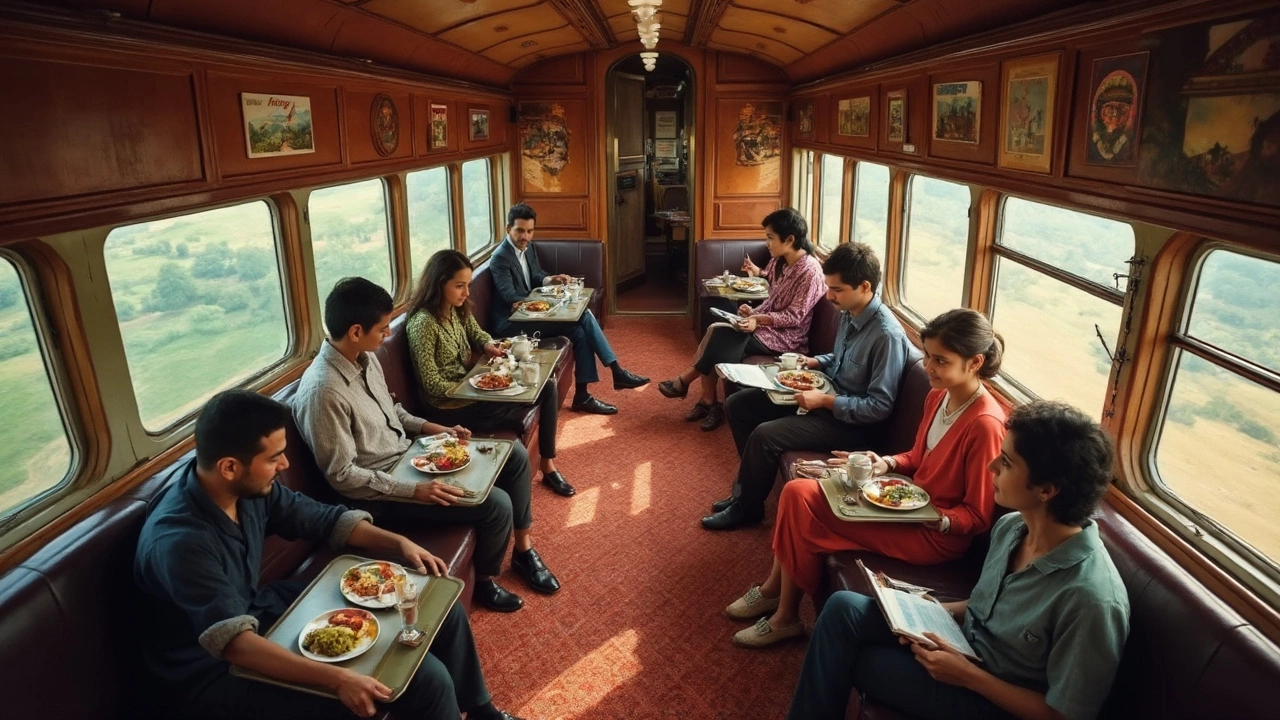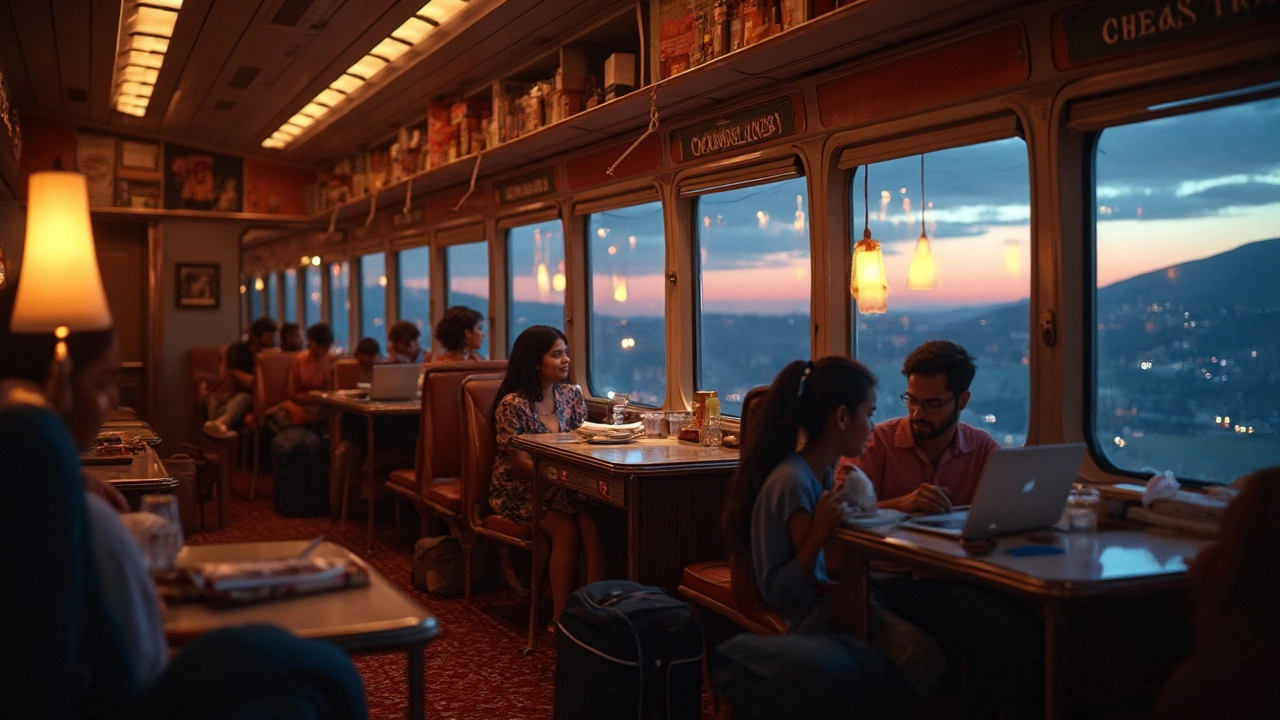Sleeper trains might sound like a thing from old movies, but they still rumble across the USA—just not as many as folks expect. If you're picturing plush cabins and silver service stretching coast to coast, it's a bit more down-to-earth—but yes, real sleeper cars exist for travelers wanting adventure and privacy while crossing big miles overnight.
Most overnight trains in America are run by Amtrak, the only major long-distance passenger rail service. Forget the cramped coach seats; when you book a sleeper, you get your own small room or a roomette, privacy, bedding, and all meals included. Think of it as a rolling hotel room with a view that changes every hour. For some, it’s a bucket-list way to see the country without the stress of airports or long highway drives.
Ready to figure out where these sleeper trains run, who they’re for, and whether luxury train travel is worth the dollars? Let’s break down what you actually get, how far your money takes you, and a few pro tips for first-timers about to board their first overnight train in the US.
- What Counts as a Sleeper Train in America?
- Routes and Where They Go
- Life Onboard: Comfort, Food, and Surprises
- Cost Breakdown and Booking Tips
- Little-Known Perks and What to Watch For
What Counts as a Sleeper Train in America?
When folks say “sleeper train” in the USA, they’re talking about trains with dedicated sleeping cars—private cabins meant for overnight travel. Sleeper trains usually belong to Amtrak’s long-distance routes. These aren’t just regular seats you try to get comfy in for a night; you’re paying for a real bed, privacy, and some perks normal train riders miss.
Here’s what you get on a true American sleeper train:
- Private roomettes or bedrooms (there’s a difference—a roomette is cozier, usually for one or two people, while bedrooms are bigger and come with their own bathroom and shower).
- Beds made up by staff (think bunk beds at night, two seats by day).
- Meals in the main dining car or delivered to your room—most tickets include breakfast, lunch, and dinner, plus soft drinks and coffee.
- A dedicated attendant for each sleeper car who handles bedding, luggage, and special requests.
- Priority boarding and access to Amtrak lounges at a few big-city stations.
Sleeper services on Amtrak go by specific names: you’ll see choices like Roomette, Bedroom, Family Bedroom, and Accessible Bedroom on their booking site. If you see “Business Class” or “Coach,” those are just normal seats—skip them if you want to sleep horizontal and have some privacy.
| Type of Sleeper Car | Features | Max. Occupancy |
|---|---|---|
| Roomette | 2 seats turning into bunk beds, shared restroom/shower in car | 2 adults |
| Bedroom | Bigger space, private restroom and shower | 2 adults (+1 child possible) |
| Family Bedroom | Extra space, for bigger groups, shared facilities | 2 adults + 2 kids |
| Accessible Bedroom | Wheelchair-friendly, private restroom, shower access | 2 adults |
Worth knowing: luxury private trains you see in Europe or Asia are rare here. The US used to have more luxury lines, but now Amtrak is pretty much the only game in town if you want a real sleeper experience. Still, Amtrak's sleeper cars beat any red-eye flight’s comfort, and the windows are a whole lot bigger.
Routes and Where They Go
When people ask about sleeper trains in the USA, they usually mean Amtrak’s long-distance routes. These trains crisscross huge stretches of the country. If you’ve got time and want to see America from the rails, you have a handful of classic options. The most famous routes all offer overnight sleeper cars—some take you across deserts, others through the Rockies, the Cascades, or right up the East Coast.
Here are some of the main lines where you can actually book a sleeping car:
- California Zephyr: Runs between Chicago and San Francisco (Emeryville, CA). It’s a two-night trip through the Rockies and the Sierra Nevadas. This is a favorite for scenery lovers.
- Empire Builder: Connects Chicago with Seattle and Portland, splitting in Spokane. You get huge changes in landscape, from Great Plains to mountains.
- Southwest Chief: Goes from Chicago to Los Angeles, cutting across the heartland, red rocks of New Mexico, and open desert.
- Crescent: Runs New York City to New Orleans. It’s a city-to-city route, but you’ll see the rolling hills of the South.
- Silver Service (Silver Meteor and Silver Star): Both run along the East Coast between New York and Miami. These are good for snowbirds heading to Florida in style.
- Texas Eagle: Chicago to San Antonio (with a segment to Los Angeles via the Sunset Limited). Expect big open spaces in the South and Midwest.
- Coast Starlight: Starts in Seattle and ends in Los Angeles, never far from the Pacific Ocean with killer coastal views along big stretches.
If you’re a stat person, here’s a quick snapshot of what these main routes look like:
| Train | Route | Distance (miles) | Travel Time (approx.) |
|---|---|---|---|
| California Zephyr | Chicago - San Francisco | 2,438 | 51 hours |
| Empire Builder | Chicago - Seattle/Portland | 2,205 | 46 hours |
| Southwest Chief | Chicago - Los Angeles | 2,265 | 43 hours |
| Coast Starlight | Seattle - Los Angeles | 1,377 | 35 hours |
| Crescent | New York - New Orleans | 1,377 | 30 hours |
| Silver Meteor | New York - Miami | 1,389 | 28 hours |
| Texas Eagle | Chicago - San Antonio | 1,306 | 32 hours |
These journeys are not sprint-to-the-finish train rides. They’re for folks who want to slow down, sleep onboard, and actually enjoy the ride. If you want that classic sleeper train experience, these are your go-to routes in America. Don’t expect high-speed service. This is all about the long-haul experience, and that’s really the charm.

Life Onboard: Comfort, Food, and Surprises
Getting a sleeper on an Amtrak train means way more than just a seat to snooze in. You get your own space—either a compact roomette or a bigger bedroom. Is it five-star hotel fancy? No, but you have a bed to sprawl out, fresh linens from the attendant, a small closet, and a seat during daylight hours. The bedrooms even come with a private toilet and shower, which is a total game-changer on longer rides.
If you go for a roomette, you share the bathroom with a few other passengers, but everything’s just down the hall. The real bonus here is privacy: door shuts, bedtime whenever you want, and you don’t have to deal with random neighbors (unless you bring one).
Food is where sleeper cars shine, especially compared to regular coach. Every sleeper ticket includes meals, and we’re talking real plates—not airplane trays. You get hot breakfast, lunch, and dinner, mostly cooked on the train. On main routes like the California Zephyr or the Empire Builder, dinner could be steak, salmon, or a vegetarian pasta, all served in the dining car with tablecloths and real silverware. Breakfasts are eggs, pancakes, or oatmeal; lunch, things like burgers or fresh salads. Tip: snag a window seat in the dining car if you can—the views beat any restaurant.
Beverages are part of the deal, but if you want alcohol, you’ll pay extra. Don’t be shy about saying hello to other diners—Amtrak often seats strangers together, so you might meet someone with wild travel stories.
Want fast Wi-Fi for streaming? Not so much. Most overnight trains offer weak or no Wi-Fi outside of major cities. Bring downloaded shows or music, and prep for patchy cell service in rural spots. Also, pack an extra charger—outlets are in the room but go fast for two travelers.
Downsides? The train rocks and rattles, especially at night. Some people sleep like babies, others need earplugs. If you’re a light sleeper, a white noise app helps a ton. And showering as the landscape flies by is a memory you won’t forget—just hang on.
Here’s a quick look at what you get with Amtrak sleeper accommodations:
| Feature | Roomette | Bedroom |
|---|---|---|
| Bed(s) | 2 (bunk style) | 2 (more spacious, bunk) |
| Private Bathroom/Shower | Shared down the hall | Yes, in-room |
| Meals Included | Yes | Yes |
| Power Outlets | 1 or 2 | 2 |
| Size | Cozy—good for solo or two passengers | Bigger—room for family or those who want space |
People often pick sleeper trains for the slow travel vibe and ever-changing views—the Rockies at dawn or Midwest farmland rolling by at dusk. Bring snacks, charge your gadgets, and lean into the pace. This isn’t just travel; it’s the journey itself that’s the star.
Cost Breakdown and Booking Tips
Booking a sleeper train in the USA isn’t cheap, but knowing what you’re paying for helps. Here’s what you get: the privacy of your own room or roomette, all meals included, and an attendant for small comforts (think turndown service and coffee in the morning). Most folks book these tickets through Amtrak, since it's hands-down the main game in town for cross-country trips.
The price varies a lot based on route, time of year, and how early you book. For example, a two-person roomette on the California Zephyr from Chicago to San Francisco can run anywhere from $600 to $1,500—one way. A bigger bedroom with its own shower stretches that to $1,200–$2,000 or even more. Prices climb fast in summer and around holidays, so flexibility can really save you cash.
| Route | Roomette (Average) | Bedroom (Average) | Coach Seat (For Comparison) |
|---|---|---|---|
| California Zephyr | $850 | $1,600 | $200 |
| Empire Builder | $900 | $1,800 | $180 |
| Silver Meteor (NY-Miami) | $750 | $1,500 | $170 |
Booking isn’t rocket science, but some tips will save hassle (and money):
- Book as early as you can—prices almost always go up as rooms sell out.
- Check if you qualify for discounts (seniors, kids, military, and rail pass holders all get deals sometimes).
- Be flexible with your travel dates to score lower fares. Sometimes just moving your trip a day or two shaves hundreds off your ticket.
- If you’re traveling with someone, share a roomette—the price doesn’t double for two people, which makes it much more affordable per person.
- Don’t forget that meals are included in sleeper fares—a sneaky value, especially if you like hearty train-car breakfasts and dinners.
Pro tip: Amtrak Guest Rewards work kind of like airline miles. If you travel often or plan a long-haul sleeper trip, join for free and rack up points—it might even get you a free sleeper upgrade down the road.

Little-Known Perks and What to Watch For
People think the experience stops at a bed and dinner, but there are extra perks on sleeper trains that most folks miss. For starters, Amtrak sleeper passengers get access to private lounges at select stations, like the Metropolitan Lounge in Chicago or the Amtrak Lounge in Los Angeles. These lounges have coffee, snacks, comfy seats, power outlets, and a quiet spot to relax before getting on board—great if your train is running late, which, let's be real, can happen a lot with American trains.
If you’re on a longer trip, you’ll notice how easy it is to socialize with other travelers. The dining car naturally puts strangers together at tables, so you walk away with stories and maybe some friends. Bonus: meals in the dining car are included for sleeping car passengers, and though the menu isn’t huge, it covers basics like steak, salmon, and vegetarian options. You also get complimentary bottled water, juice, coffee, and sometimes snacks in your room. Pro tip: On routes like the California Zephyr and Southwest Chief, staff sometimes bring in regional wine or local treats for tastings. You won’t find that in coach class.
On the less glamorous side, sleeper train bathrooms are shared on most routes unless you splurge for a Bedroom, which comes with a private toilet and shower. Roomettes have more privacy than seats, but you’ll still need to walk down the hall for a shower. Plus, these rooms are not massive. If you have two large suitcases, one will probably live on the luggage rack, not in your room.
Wi-Fi is spotty—sometimes it’s non-existent in the middle of nowhere. Download movies and playlists ahead. And delays? They're pretty common; freight has priority over passenger trains in the US, so don’t schedule anything tight after your arrival.
| Feature | Sleeper Cars | Coach Class |
|---|---|---|
| Private Lounge Access | Yes (major stations) | No |
| Meals Included | Yes (dining car) | No (café only, pay extra) |
| Bedding Provided | Yes | No |
| Private Room Option | Yes | No |
| Shower Access | Shared or Private | Shared only on select trains |
| Power Outlets | Yes (inside room) | Usually yes (at seat) |
One last heads-up: tipping is expected. Bring some small bills—most people tip their car attendant $5 to $10 per night, more if they go above and beyond with service.
